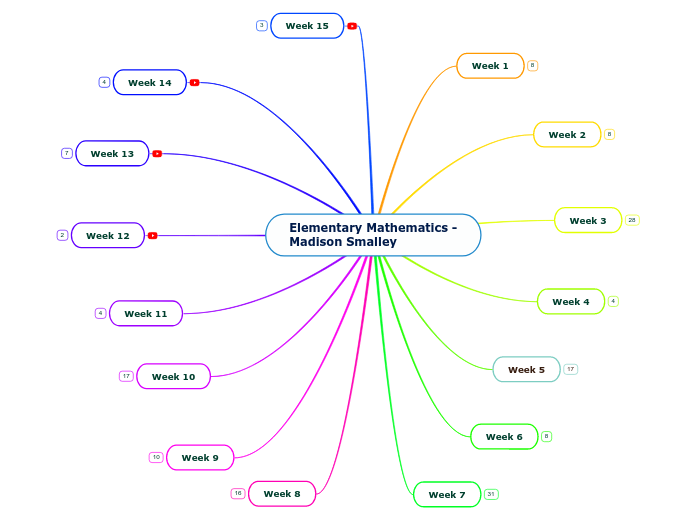par Madison Smalley Il y a 5 années
406
Elementary Mathematics - Madison Smalley

par Madison Smalley Il y a 5 années
406

Plus de détails
Subtracting Integers
A group of zero pairs = zero bank
++ - - - - - - - - -
Area
Finding the fraction of a specific area from a bigger area
Set
Example: 3/7 Red or 4/7 Not Red
Linear
using length for fraction
Numerator = what we have Denominator = the size of the pieces we have
Group 3
6,7,8,9: Harder to count or do any math problems
Group 2
3 and 4: small numbers
Group1
2,5,10: Easy to count, multiply, divide, add, and subtract
8
Look at the last three digits, divide by 8, then yes
4
Look at the last two digits, divide 4, then yes
6
If two and three work, then yes
9
Sum of the digits, divide by 9, then yes
3
Find the sum of the digit. If the whole number could be divided by three, then yes
10
If the one's digit is a zero, then yes
5
If the number ends in a 5 or a zero, then yes
2
If the number is even, then yes
Groups
5&10, 3&9, 4&8, 2,3&6
Subtopic
Left To Right: 32(29)
Expanded: 23(16)
1. Start with 1,2,5,10. Skip counting. 2. 3,9, doubles, also skip counting. 3. The rest of the numbers.
3 different groups:
Timed tests are not beneficial for students. It is more for the teachers to take the results and teach the class on the subjects that need it more.
469-264= 205. Take 4-2, 6-6, then 9-5. This makes it easy for student to keep place value.
46-12/ 40-10&6-2 = 34
30-17/ +3 to both sides, making 33-20= 13
28-16/ Taking the 28 and turning it into the base ten blocks, having two longs and eight units. Then turn the 16 into one long and 6 units. You would take one long from each number, the take away 6 units from each. This allows students to keep place value as well as seeing it physically.
24+43+76+39+17/ Bring numbers that will add up to 10 together. Such as 4, from 24, and 6, from 76, making the 24 a 30, and a 70. Then the 7 from 17, to 3 from 43. making the 17 to 10, then 43 to 50. Then you will have 30+50+70+10. Adding 199.
37+88/ Taking numbers away from one number and adding it to the other to create a number ending in zero. You would take 2 from the 37, then add it to the 88. Creating 35+90= 125
24=68=37=59/ Adding number until you get to ten. You would start by writing the numbers vertically, leaving space between the numbers. You would start with the units. 4+8= 12, so you would draw a line through the 8, then write a 2 next to it, signally 12. You would then add that 2 to the 7, creating 9, you then add the next number, 9. Creating 18, so you would draw a line through 9, then write a 8 next to it, signally 18. You would write the 8 at the bottom, then count the lines through the numbers. Since there was 2, you would put 2 about the 2 in 24. Then you add the 10's digits together. 2+2+6, this creates 10, so you would draw a line through the 6, then put a 0 next to it, signally a 10. Add the rest the numbers continuing this process. At the end you will have 8 at the bottom. You will then count the lines, then put that on top of the 100's place. Since there is no other number, that 1 will just drop down. Meaning 24+68+37+59=188.
246+159/ You would rewrite the numbers vertically. You would then make a box from the bottom line. Then draw two more lines creating 3 boxes for the three place values. You will then draw diagonal lines, causing the boxes to turn into triangles. You then add normally, 6+9 is 15, so you would write 15 in the triangles under 6&9. You will the same process for the rest of the numbers. After you will add diagonally. so 5+nothing=5, 1+9 is 10, so you would write a zero then bring the one to the next number, so 1+0+3=4, and so on. You will end up with 405.
537+265/ Take 5&2, add those two numbers together, creating 7, then 6+3=9, 7+5=12. You then can re write the number out again with the correct place value, but older students could process the 12 adding to the 10's digit. 537+265= 802.
224+437/ You would write each number at based on their place value. 200+400, 20+30, 4+7. Making 600+50+11. Making 661.
Using 10 Frames to visually show the numbers, and adding them together.